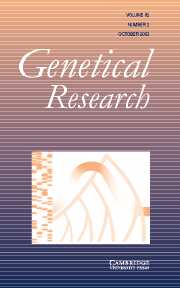Refine listing
Actions for selected content:
Contents
Research Article
Target sequences of Tc1, Tc3 and Tc5 transposons of Caenorhabditis elegans
-
- Published online by Cambridge University Press:
- 11 November 2003, pp. 85-88
-
- Article
-
- You have access
- Export citation
Relative roles of mutation and recombination in generating allelic polymorphism at an MHC class II locus in Peromyscus maniculatus
-
- Published online by Cambridge University Press:
- 11 November 2003, pp. 89-99
-
- Article
-
- You have access
- Export citation
Unusual pattern of single nucleotide polymorphism at the exuperantia2 locus of Drosophila pseudoobscura
-
- Published online by Cambridge University Press:
- 11 November 2003, pp. 101-106
-
- Article
-
- You have access
- Export citation
Sex determination in crayfish: are intersex Cherax quadricarinatus(Decapoda, Parastacidae) genetically females?
-
- Published online by Cambridge University Press:
- 11 November 2003, pp. 107-116
-
- Article
-
- You have access
- Export citation
The genetics of mating recognition between Drosophila simulans and D. sechellia
-
- Published online by Cambridge University Press:
- 11 November 2003, pp. 117-126
-
- Article
-
- You have access
- Export citation
An EM algorithm for mapping binary disease loci: application to fibrosarcoma in a four-way cross mouse family
-
- Published online by Cambridge University Press:
- 11 November 2003, pp. 127-138
-
- Article
-
- You have access
- Export citation
Inferences regarding the numbers and locations of QTLs under multiple-QTL models using interval mapping and composite interval mapping
-
- Published online by Cambridge University Press:
- 11 November 2003, pp. 139-149
-
- Article
-
- You have access
- Export citation
Book Review
Microarray Gene Expression Data Analysis: A Beginners Guide. H. C. CAUSTON, J. QUACKENBUSH and A. BRAZMA. Blackwell Publishing. 2003. 160 pages. ISBN 1405106824. Price £34.99 (paperback).
-
- Published online by Cambridge University Press:
- 11 November 2003, pp. 151-152
-
- Article
-
- You have access
- Export citation
The Origin of Species Revisited. DONALD R. FORSDYKE. McGill-Queen's University Press. 2001. 275 pages. ISBN 0-7735-2259-X. Price £37.95 (hardback).
-
- Published online by Cambridge University Press:
- 11 November 2003, pp. 152-153
-
- Article
-
- You have access
- Export citation
